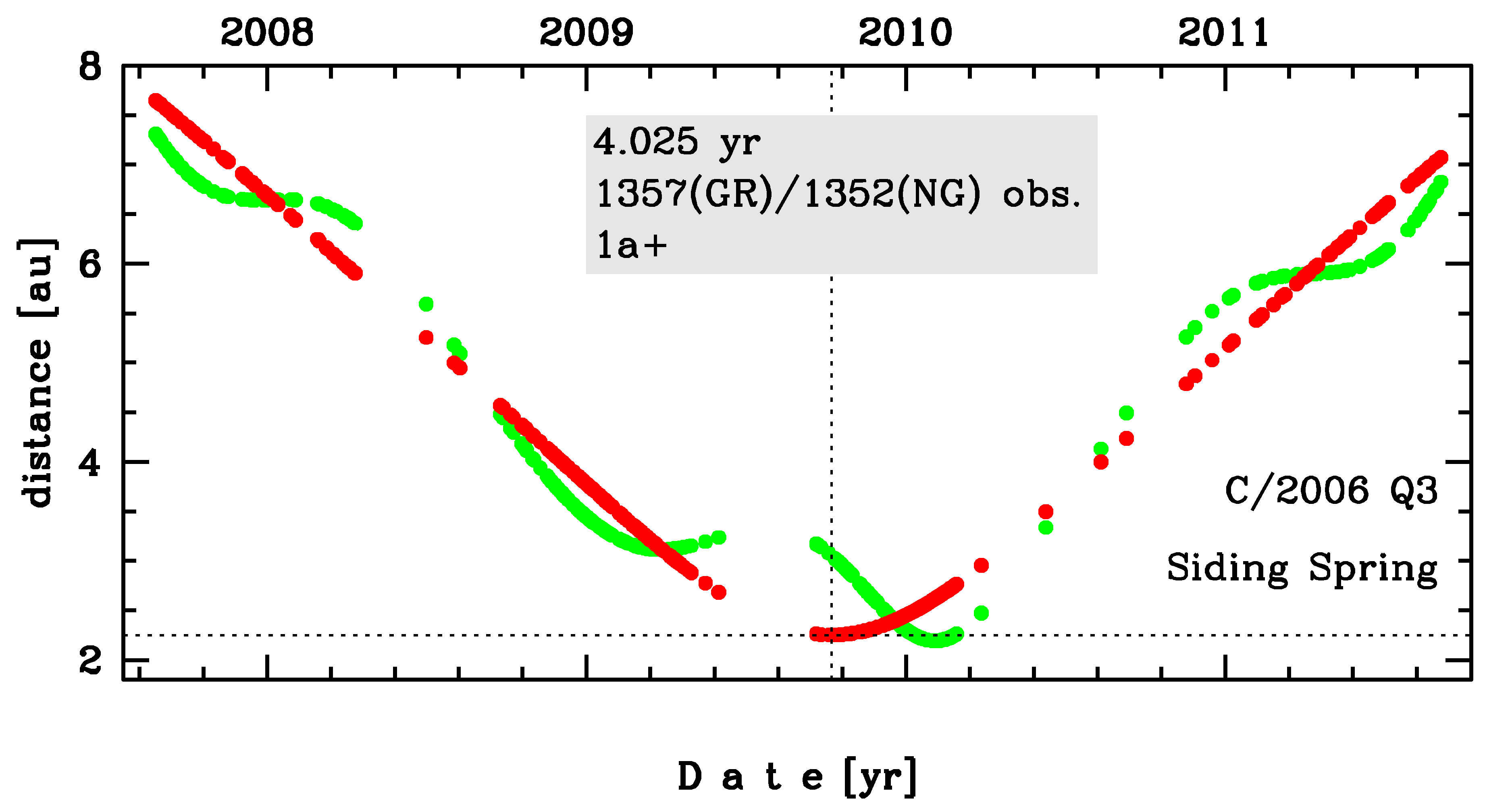C/2007 Q3 Siding Spring
more info
Comet C/2007 Q3 was discovered on 25 August 2007 with Siding Spring survey; that is a bit more than 2 years before its perihelion passage. It was observed until 3 September 2011 (see picture).
Comet had its closest approach to the Earth on 2 February 2010 (2.193 au), about 4 months after its perihelion passage.
C/2007 Q3 is a comet with non-gravitational effects strongly manifested in positional data fitting. Preferred (non-gravitational) solution given here is based on data spanning over 4.02 yr in a range of heliocentric distances: 7.64 au – 2.252 au (perihelion) – 7.07 au. However, it was difficult to indicate the preferred model for this comet. Therefore, we show also second global non-gravitational solution based on g(r)-like function dedicated to CO (dc solution based on data taken at large heliocentric distances). In addition, there are two further solutions: NG orbit for pre-perihelion arc of data (g(r)-like function consistent with CO) dedicated for past orbital evolution, and a pure gravitational orbit based on post-perihelion data taken at heliocentric distances starting from 3.5 au and dedicated to future evolution. From the dynamical perspective, all these solutions give a fairly precise range of original 1/a values from 28 to 41 in units of 10-6 au-1. The solution given in the Nakano Notes (NG orbit) is also placed inside this range of original 1/a, but the MPC solution (GR orbit) results in a slightly lower value of original 1/a.
This Oort spike comet suffers rather large planetary perturbations during its passage through the planetary system and these perturbations lead to more tight future orbit (see future barycentric orbits).
See also Królikowska and Dybczyński 2013 and Królikowska 2020.
Comet had its closest approach to the Earth on 2 February 2010 (2.193 au), about 4 months after its perihelion passage.
C/2007 Q3 is a comet with non-gravitational effects strongly manifested in positional data fitting. Preferred (non-gravitational) solution given here is based on data spanning over 4.02 yr in a range of heliocentric distances: 7.64 au – 2.252 au (perihelion) – 7.07 au. However, it was difficult to indicate the preferred model for this comet. Therefore, we show also second global non-gravitational solution based on g(r)-like function dedicated to CO (dc solution based on data taken at large heliocentric distances). In addition, there are two further solutions: NG orbit for pre-perihelion arc of data (g(r)-like function consistent with CO) dedicated for past orbital evolution, and a pure gravitational orbit based on post-perihelion data taken at heliocentric distances starting from 3.5 au and dedicated to future evolution. From the dynamical perspective, all these solutions give a fairly precise range of original 1/a values from 28 to 41 in units of 10-6 au-1. The solution given in the Nakano Notes (NG orbit) is also placed inside this range of original 1/a, but the MPC solution (GR orbit) results in a slightly lower value of original 1/a.
This Oort spike comet suffers rather large planetary perturbations during its passage through the planetary system and these perturbations lead to more tight future orbit (see future barycentric orbits).
See also Królikowska and Dybczyński 2013 and Królikowska 2020.
| solution description | ||
|---|---|---|
| number of observations | 1352 | |
| data interval | 2007 08 25 – 2011 09 03 | |
| data type | perihelion within the observation arc (FULL) | |
| data arc selection | entire data set (STD) | |
| range of heliocentric distances | 7.64 au – 2.25 au (perihelion) – 7.07 au | |
| type of model of motion | NS - non-gravitational orbits for standard g(r) | |
| data weighting | YES | |
| number of residuals | 2658 | |
| RMS [arcseconds] | 0.39 | |
| orbit quality class | 1a+ | |
| next orbit statistics, both Galactic and stellar perturbations were taken into account | ||
|---|---|---|
| no. of returning VCs in the swarm | 5001 | * |
| no. of escaping VCs in the swarm | 0 | |
| no. of hyperbolas among escaping VCs in the swarm | 0 | |
| next reciprocal semi-major axis [10-6 au-1] | 117.73 – 118.93 – 120.19 | |
| next perihelion distance [au] | 2.139 – 2.143 – 2.147 | |
| next aphelion distance [103 au] | 16.6 – 16.8 – 17 | |
| time interval to next perihelion [Myr] | 0.758 – 0.77 – 0.782 | |
| percentage of VCs with qnext < 10 | 100 | |

Upper panel: Time distribution of positional observations with corresponding heliocentric (red curve) and geocentric (green curve) distance at which they were taken. The horizontal dotted line shows the perihelion distance for a given comet whereas vertical dotted line — the moment of perihelion passage.
Lower panel (panels): O-C diagram for this(two) solution (solutions) given in this database, where residuals in right ascension are shown using magenta dots and in declination by blue open circles.
Lower panel (panels): O-C diagram for this(two) solution (solutions) given in this database, where residuals in right ascension are shown using magenta dots and in declination by blue open circles.
| next_g orbit statistics, here only the Galactic tide has been included | ||
|---|---|---|
| no. of returning VCs in the swarm | 5001 | * |
| no. of escaping VCs in the swarm | 0 | |
| no. of hyperbolas among escaping VCs in the swarm | 0 | |
| next reciprocal semi-major axis [10-6 au-1] | 117.74 – 118.95 – 120.21 | |
| next perihelion distance [au] | 2.135 – 2.139 – 2.143 | |
| next aphelion distance [103 au] | 16.6 – 16.8 – 17 | |
| time interval to next perihelion [Myr] | 0.758 – 0.77 – 0.782 | |
| percentage of VCs with qnext < 10 | 100 | |